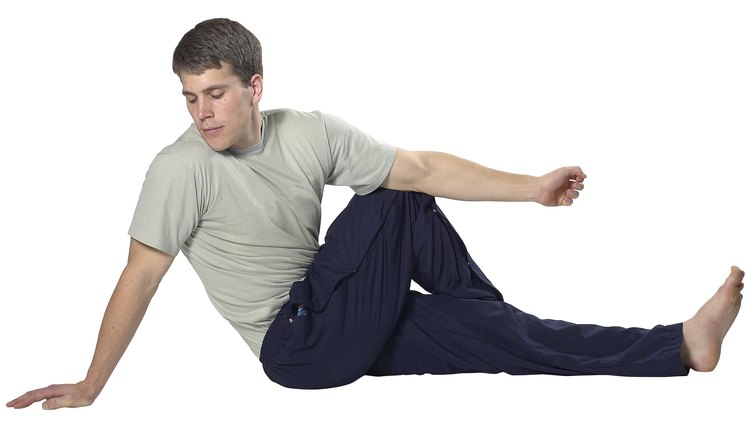Does Stretching Release Lactic Acid?

When you perform strenuous exercise you breathe faster as your body demands more oxygen to feed your hard-working muscles. Your body favors creating the bulk of its energy through aerobic activities, and oxygen is the body’s basic supply. During vigorous workouts, however, your body’s demand for energy can exceed its supply -- creating an internal anaerobic process called glycolysis, when the body pulls energy from glucose stores to sustain your energy through the activity. When oxygen is limited, your body generates lactate to enable glucose breakdown, and in the process lactate levels build up within the muscle. Stretching can help release lactate buildup following exercise.
Stretching Shortened Muscles
The best time to stretch to release lactate, more commonly called lactic acid, is after a strength-training workout, such as weightlifting. Stretching after you’ve fatigued muscles provides several benefits including improved flexibility, greater muscle growth and a reduction of post-exercise muscle tenderness. After a strenuous workout, your muscles shorten and bulge from repetition of intense exercise that does not take the muscle through a full range of motion. This is called the “pumped up” effect. The muscle’s increase in size comes from the buildup of lactic acid and other waste products in the muscle, according to Massachusetts Institute of Technology (MIT). Stretching releases the concentration of lactic acid, helping to loosen and lengthen the muscle so it can achieve a full range of motion.
Stretching Can Prevent Post-Exercise Soreness
According to MIT, if you don’t stretch following rigorous activity, the muscle will retain a decreased range of motion, almost forgetting how to lengthen itself. When this occurs, most people experience post-exercise soreness from lactic acid and other waste-product concentrations. Although stretching reduces the size of the muscle’s appearance as you loosen it and release lactate, losing that “pumped” look, you will continue to achieve muscle growth.
Strengthening and Stretching the Right Muscles
Reserve stretching exercises for short, tight muscles; don’t stretch long, loose muscles, advises physical therapist, Damien Howell. A shortened muscle needs stretching to release lactic acid concentrations, but the same is not true for adjacent muscles that are loose. Loose muscles need strengthening. The key to creating the best sequence for you will combine and alternate stretching of tight shortened muscles and strengthening loose, weakened muscles. As you get fit, you should combine strength and stretching exercises. When you strengthen a group of muscles be sure to stretch those muscles; however, don’t stretch muscles you have not exercised; rather strengthen them, Howell says. Always consult your physician before you begin a new exercise regiment.
Stretching Safety
Not all stretching exercises are the same. While stretching improves flexibility through the lengthening of the muscle and release of lactic acid following intense activity, some stretching activities are not safe for every individual. Common stretching exercises include static, sustained stretches that require slow, controlled movements that are gently held for 10 to 60 seconds and repeated three times. While these stretches are considered safe for most people, consult with your physician to protect against injuries.
References
Writer Bio
Tina Boyle has been writing since 2000. Trained as a journalist, she has traveled to over 150 US cities. She specializes in travel, culture, pets, business and social networking and regularly publishes in newspapers, magazines and on Web sites. She received a Bachelor of Arts in writing from the College of Santa Fe.
